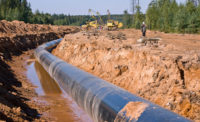Federal regulators dealt a blow recently to Williams Partners L.P. in putting off a decision for six months on whether the firm's plans to build a 3.17-mile natural gas pipeline extension off the coast of the Rockaway peninsula in Queens is approved.

Williams had planned to start work on the $182-million Rockaway Delivery Lateral Project this month but the Federal Energy Regulatory Commission (FERC) said in August that it would complete the project's final environmental impact statement on Feb. 28, 2014, with a 90-day federal authorization decision deadline of May 29.
Williams had anticipated already starting construction on the meter and regulator stations of the planned project, which will connect with its existing 10,200-mile Transco pipeline system.
The project involves building a 26-in lateral pipeline about 2.9 miles off the coast and 0.3 miles onshore under Jacob Riis Park to Floyd Bennett Field in Queens. Using conventional marine lay and trenching methods, it includes building the meter and regulator stations inside one of the historic hangar buildings at Floyd Bennett Field and restoring the facade to that structure. A separate Transco project, also awaiting FERC approval, involves modifying existing compressor facilities in Delta, Penn.; Princeton, N.J.; and Old Bridge, N.J.
FERC's deadline will affect Williams' building schedule plan for the meter stations but will not affect the pipeline's November 2014 in-service date, says Chris Stockton, a Williams spokesman.
"Our goal is to receive our FERC approval as early as March 2014. If that happens, our plan is to begin meter station construction in April 2014," Stockton says. "That will take six to seven months to complete. We’d begin offshore construction in April as well. That will be a six-month process," he says. He adds that FERC's May 29 date is a deadline, "not an issuance date."
The proposed pipeline would interconnect with a 12,000-ft, 26-in proposed pipeline that National Grid plans to install in Flatbush Ave. from Floyd Bennett Field to Avenue U, says Karen Young, a National Grid spokeswoman. Because the National Grid portion is under the city's jurisdiction, it does not need FERC approval but is pending city approvals, she adds.
National Grid is also building two, 1.6-mile pipelines under the Rockaway inlet and within an already approved cable right-of-way, Young says. One line is meant to connect with the proposed Transco project.
The other connects National Grid's existing distribution systems in Brooklyn and Queens to each other, providing a back feed for both areas, she says. "It also will make sure we have adequate natural gas supply for the Rockaways," she adds. Michels Pipeline Contrustion, Brownsville, Wisc., is the contractor on this project, which is expected to be completed in November, she says.
National Grid began work on those two lines last spring at Beach 169th St. in the Rockaways, parallel with the Marine Parkway-Gil Hodges Memorial Bridge to the intersection of Flatbush Ave. and Aviation Rd.
But the Transco project, like several other pipeline extension projects in the Northeast, has been criticized by environmentalists, area residents and other groups. They say that the Rockaway project puts public health and safety as well as the environment at risk and that there are better and safer alternatives to energy supply.
"The location of the pipeline doesn't make sense," says Martha Cameron, a coordinator of the grassroots Coalition Against the Rockaway Pipeline. The project runs through a large portion of Gateway National Recreation Area, the National Park Service's 26,000-acre region of marshes and wildlife sanctuaries for more than 300 species. "If anything goes wrong with this pipeline, there is a very real possibility that that area will be threatened," she says.
"We don't need the gas, which is not clean energy," Cameron says. If the project goes through, the city "is handing over our land to a private contractor for profit," she adds.
The project is also in "the area precisely where Sandy came through, Cameron says. "This is nuts."
But Williams does not agree with that assessment and is "very optimistic" that FERC will approve the project for several reasons, Stockton says. These include that National Grid, a customer of Williams, asked for the pipeline and "needs the gas," he says.
The existing Transco pipeline already provides half the gas used in New York City, Stockton says. While the proposed extension would add only about 100 million cu ft of additional capacity, it would allow National Grid to shift existing volumes from its Long Beach delivery point to the new lateral point to address reliability and shifting usage patterns with its system, he says.
Stockton says the project has been designed to have only minimal environmental impacts and allow the city to meet its PlaNYC clean energy goals, and is safe.
Meanwhile, FERC last year approved Williams' plans to extend its pipeline through northern N.J. wetlands as part of Transco's "Northeast Supply Link Project." The project calls for building 13 miles of pipe segments in Pennsylvania and New Jersey, which will boost supply to those markets as well as New York. Critics also oppose this project, especially as it will run through northern N.J. wetlands. FERC said in its decision, however, that this project does not pose a threat to the environment.
(This story has been amended to reflect that the project is awaiting a FERC decision.)




Post a comment to this article
Report Abusive Comment